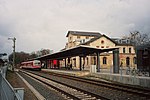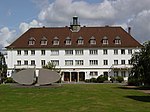Kleines Schloss (Wolfenbüttel)
Baroque architecture in Lower SaxonyBuildings and structures in WolfenbüttelCastles in Lower Saxony

The Kleine Schloss (Little Castle) in Wolfenbüttel is a Baroque building in the town of Wolfenbüttel in Lower Saxony. It is sited next to the Schloss Wolfenbüttel on what is now the Schlossplatz. It was first built in 1643 but has been frequently extended, demolished and rebuilt.
Excerpt from the Wikipedia article Kleines Schloss (Wolfenbüttel) (License: CC BY-SA 3.0, Authors, Images).Kleines Schloss (Wolfenbüttel)
Schlossplatz,
Geographical coordinates (GPS) Address External links Nearby Places Show on map
Geographical coordinates (GPS)
| Latitude | Longitude |
|---|---|
| N 52.161944444444 ° | E 10.530277777778 ° |
Address
Kleines Schloss (Bevernsches Schloss)
Schlossplatz 14
38304 , Heinrichstadt
Lower Saxony, Germany
Open on Google Maps









